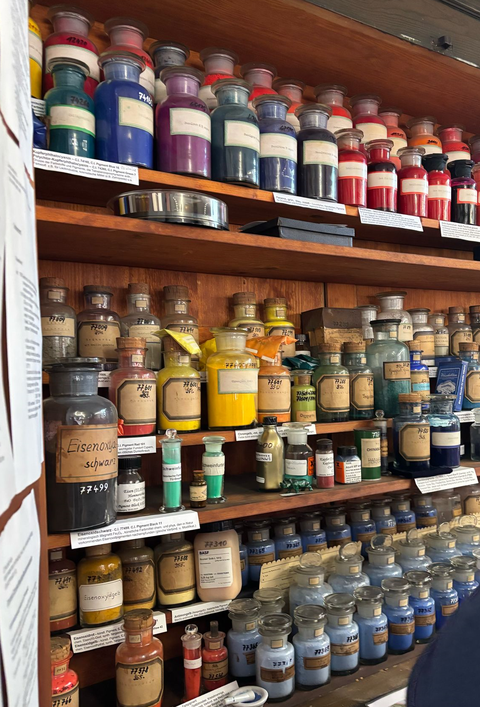Mar 28, 2025
Journey into the past - the RTG visits the historical dye collection
On Thursday, March 20, 2025, the dotoral students and the managing director of the Boysen-TUD-Research Training Group had registered for a guided tour of the Historical Dye Collection of the Faculty of Chemistry and Food Chemistry at TU Dresden. During the tour of the collection, all participants were impressed by the sheer size and variety of the samples on display.
The dye collection is known as one of the oldest and largest of its kind and includes over 1,500 natural dyes from plant and animal sources as well as over 20,000 commercial samples of synthetic dyes from more than 80 industrial manufacturers. The collection also includes an impressive number of color sample cards and dye samples, which are part of the numerous scientific papers kept in this room. Prof. Dr. Horst Hartmann (pictured above, 2nd from left), who led a tour of the collection, provided valuable insights into the history of dye production and highlighted some of the challenges and innovations that have shaped the industry. Highlights of the collection included the first usable tar dye, produced by W. Perkin in 1856, and the original sample of aniline purple. A curiosity is that it took thousands of snails to produce a small amount of Tyrian Purple, an ancient dye that was highly prized for its deep, rich purple color. The dye was eventually banned due to the excessive harvesting of sea snails.

The impressive colour collection.
However, it wasn't just the numbers that impressed. For research students, it is fascinating to look at the work of those who researched far before them, who sought to understand the world and push the boundaries of human knowledge.
Even more fascinating, however, is the desire to preserve these discoveries. In an age where data is stored everywhere, it is hard to imagine that earlier explorers had to carefully label and preserve each discovery by hand, as was evident from many of the books presented in the tour. For today's projects and also the work of the students, it is a real motivation to see how findings were passed on in the past. Nowadays, there are so many resources available that it is almost shameful to think how much knowledge was gained in the past with so many fewer opportunities. This should remind us early-career researchers to build on the work of our predecessors and to view research work as a continuous process.
The participants of the tour are grateful for the opportunity to learn from the experiences of previous generations and to contribute their own findings to the ongoing history of scientific progress.

